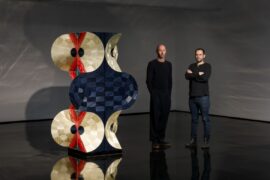Nikolai Kotlarczyk presents his debut collection at Stockholm Furniture Fair 2017
There is no better sense of camaraderie then when one of our own is killing it outside of Oz. I think it’s because unlike the seemingly small pond of the Australian market, getting noticed in the conversely massive Europe is a huge coup. The competition doubles, if not triples; there’s more media, more potential buyers… more everything. This presents a particular problem for solo designers who have to double their output just to stay afloat. It’s incredibly tough – but not impossible.
The debut collection by Copenhagen based Australian designer Nikolai Kotlarczyk presents a series referencing the aesthetic, ritualistic and emotive aspects of the Catholic Church in central Europe – all from the unique perspective of a non-native European – an Australian.
Nikolai Kotlarczyk, originally from Mullumbimby next to Australia’s most easterly point, worked within the Australian design industry for many years after graduating from the Queensland College of Arts in 2007 (Bachelor of Design, majoring Interior Design). After working with renowned Australian manufacturer Tait until 2013, Nikolai moved his studio to Denmark’s capital Copenhagen.
His debut series highlights the apparent contradictions of the church, a conflict of modesty and opulence, masculinity and feminism, modernity and tradition. These contradictions are highlighted through objects that mix robust materials with hazy transparencies, honest reflections with abstract figures, and feminine colourways with tribal motifs. The ritualistic act of the offering, the use of architectural mandalas and the idea of self-reflection are all explored within the series.
The form of the Rose coffee table brings an instant visual connection to stained glass windows of many catholic churches throughout Europe. Architects used the rose formations as a type of mandala, bringing order out of chaos and giving form to the unformed. By combining these simple circular sections, new and interesting voids were created within the church walls. These voids always contained a symmetry and order due to the repetition of this simple shape. The opal matte glass top, presenting a halo of the circular forms below, further softens the pink coloured steel frame.
The Barocche series of solid brass mirrors are composed from the graphic interpretations of floor plans from three distinct churches in central Europe. The placement of these domes and columns reveals almost tribal masks from within the make-up of their physical environments. Spaces where individuals go to face their own demons, the Barocche Mirrors aim to question ones own reflection. Produced from mirror polished brass with oxidized patterns.
One ritual practiced across religions and societies is that of offering to a higher being. Whether flowers and candles, or even fruit, this act of giving in turn changes these items from everyday to something more significant. The Halo vase aims to bring a small space into the home where one can signify this act of collecting and giving. The reflection of the polished brass back highlights the flowers or leaves displayed in the ceramic stem, creating a small space with heightened significance.
Nikolai’s work serves as a strong reminder that the design talent of Australia and the Asia Pacific represents a new era in design iconography; one where we are leaders not followers, pushing the industry to a future unburdened by the traditions faced by our European industry counterparts.
‘On ya, Nikolai!
INDESIGN is on instagram
Follow @indesignlive
A searchable and comprehensive guide for specifying leading products and their suppliers
Keep up to date with the latest and greatest from our industry BFF's!

In this candid interview, the culinary mastermind behind Singapore’s Nouri and Appetite talks about food as an act of human connection that transcends borders and accolades, the crucial role of technology in preserving its unifying power, and finding a kindred spirit in Gaggenau’s reverence for tradition and relentless pursuit of innovation.

Within the intimate confines of compact living, where space is at a premium, efficiency is critical and dining out often trumps home cooking, Gaggenau’s 400 Series Culinary Drawer proves that limited space can, in fact, unlock unlimited culinary possibilities.

The 2025 Osaka World Expo 2025 is well and truly open, with Buchan’s Pavilion representing Australia on the global stage.

Laminex – a brand synonymous with laminate surfaces to the extent that its name has become a byword for the product itself – further solidifies its position at the forefront of design innovation.
The internet never sleeps! Here's the stuff you might have missed

His name is revered and his work acclaimed, and John Wardle continues to make his presence felt on the built landscape of Australia like no other.

Melbourne design Week is just around the corner and here’s a glimpse of what to expect!

From the industry-defining impact of the humble fabric swatch to the resonant statement on relevance and innovation at this year’s Salone del Mobile, Knoll’s material excellence continues to shape the world of design. Here, we explore this extraordinary legacy and look at how it informs the brand’s contemporary expression and the future of design.